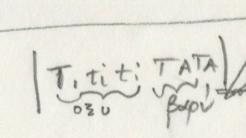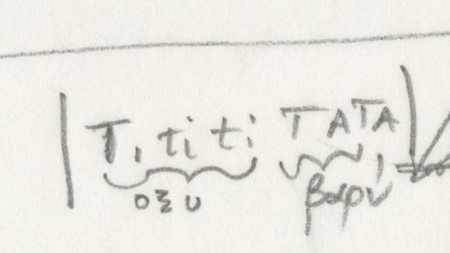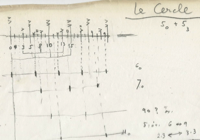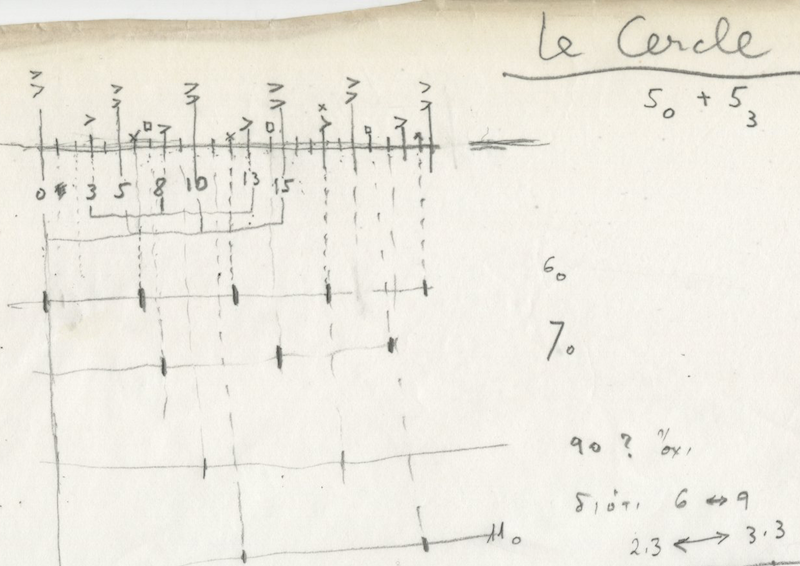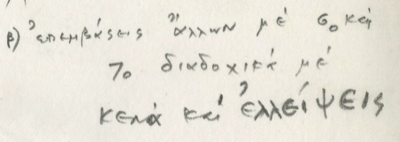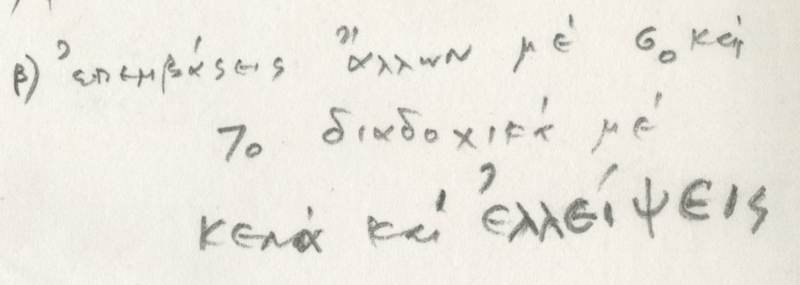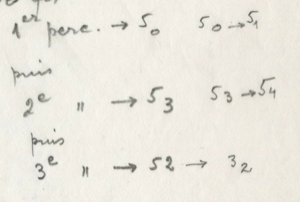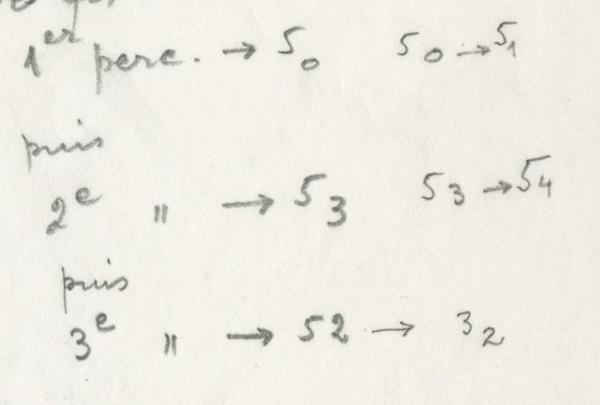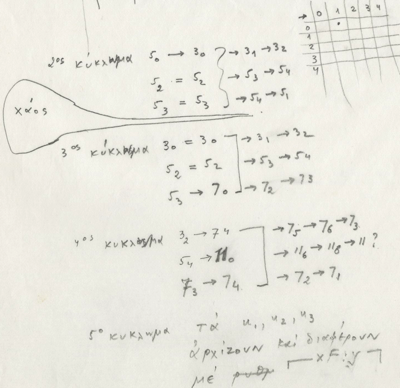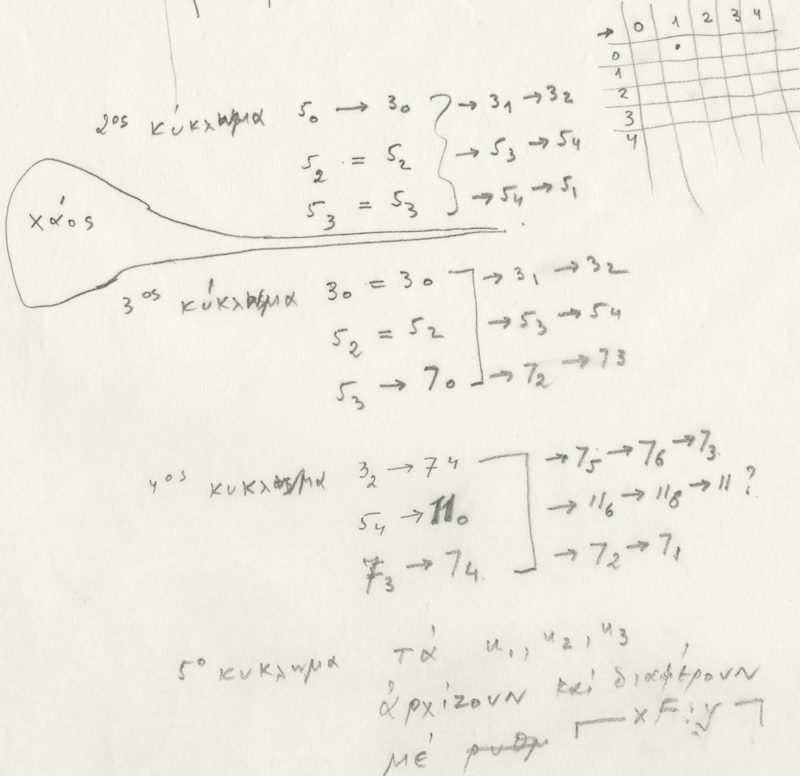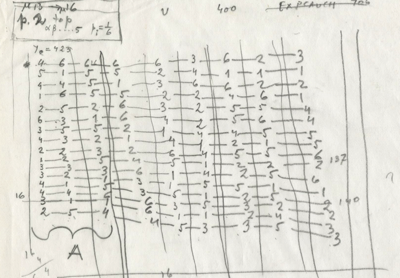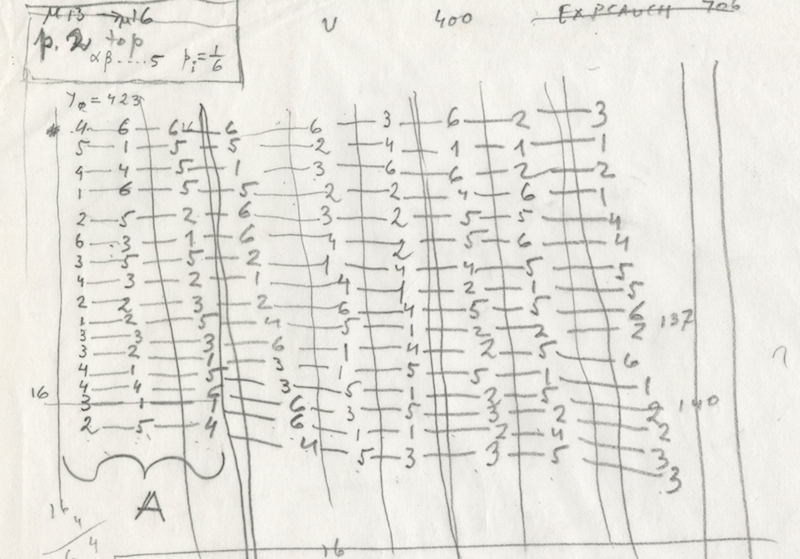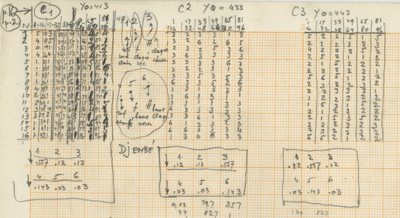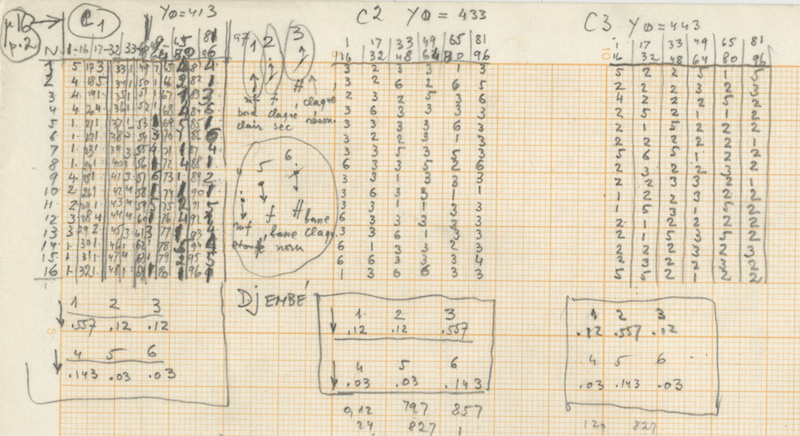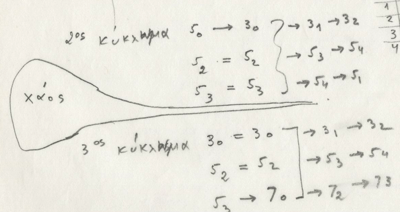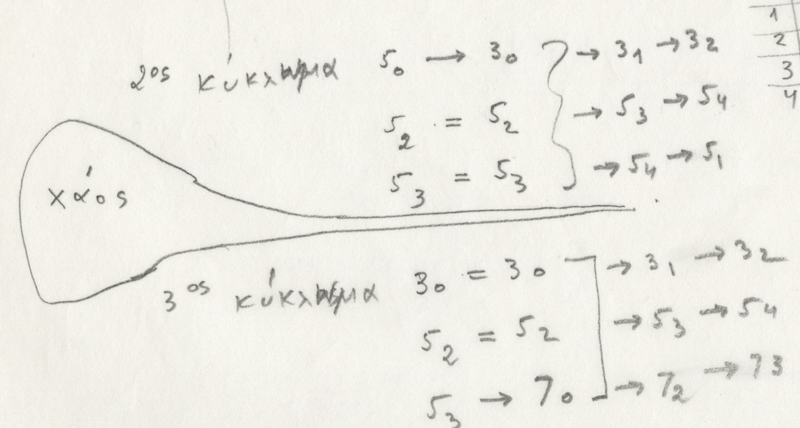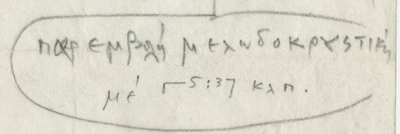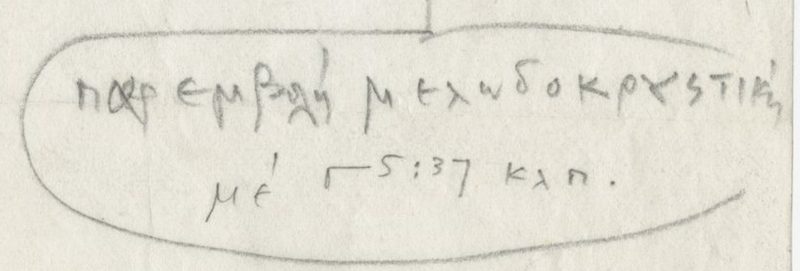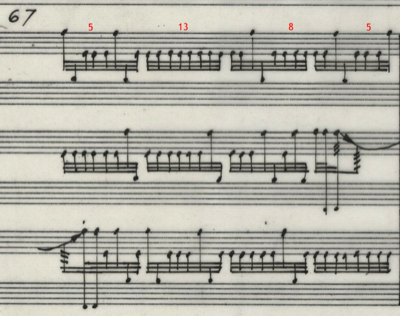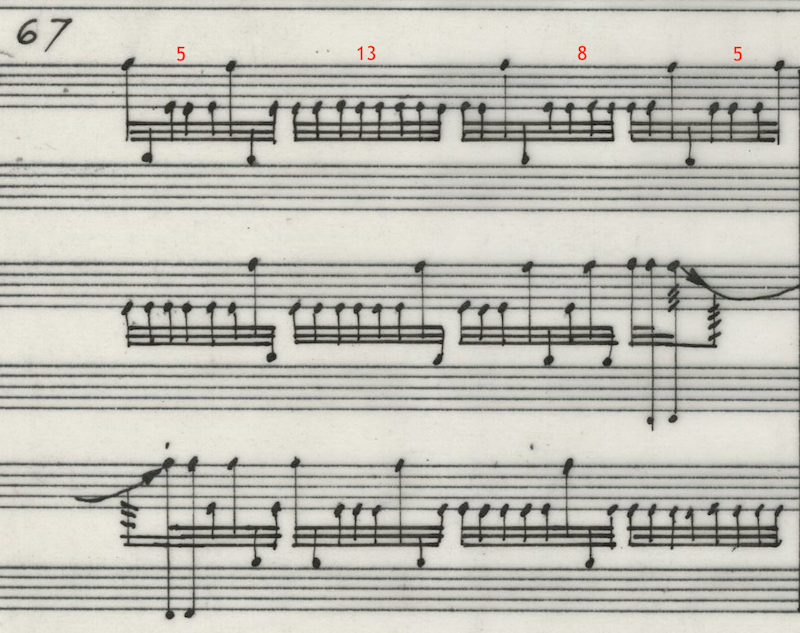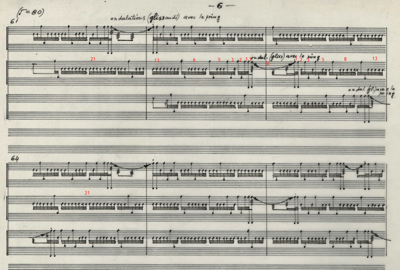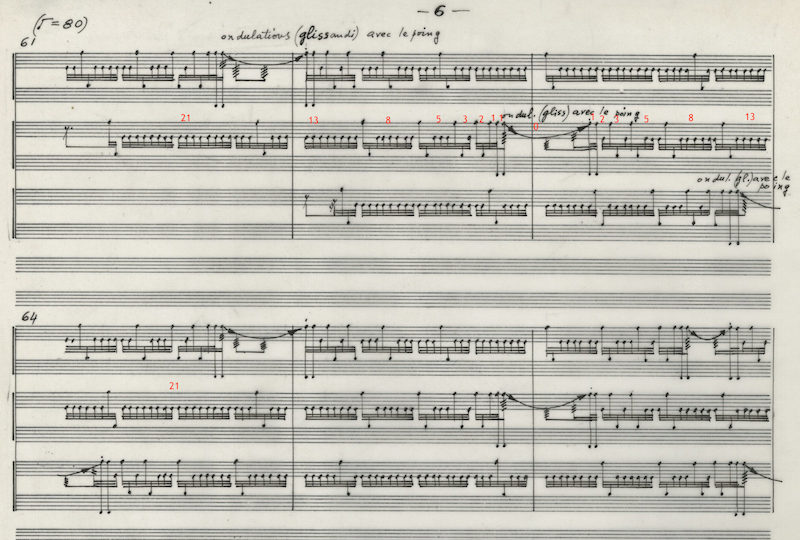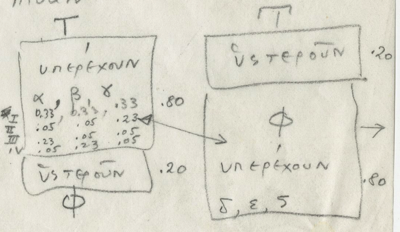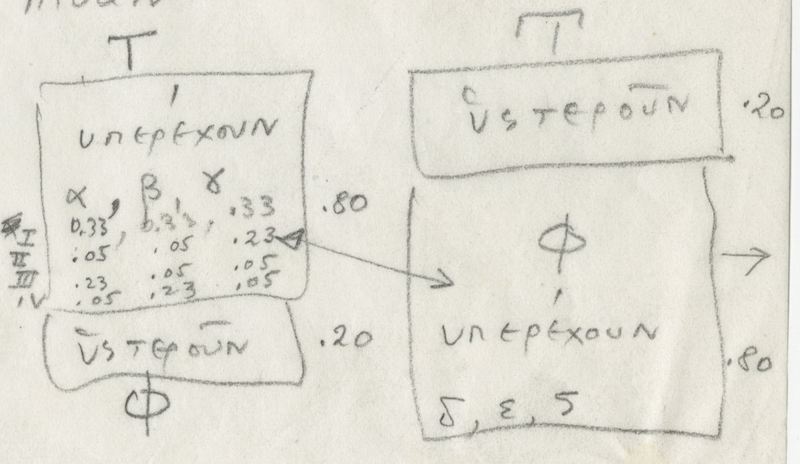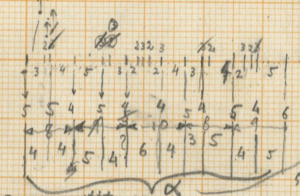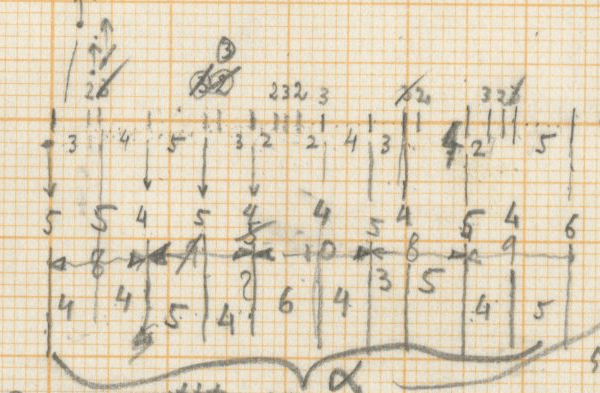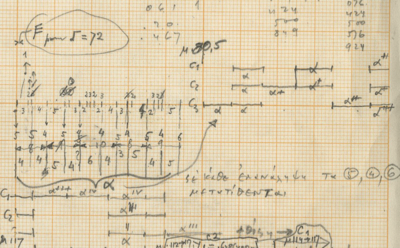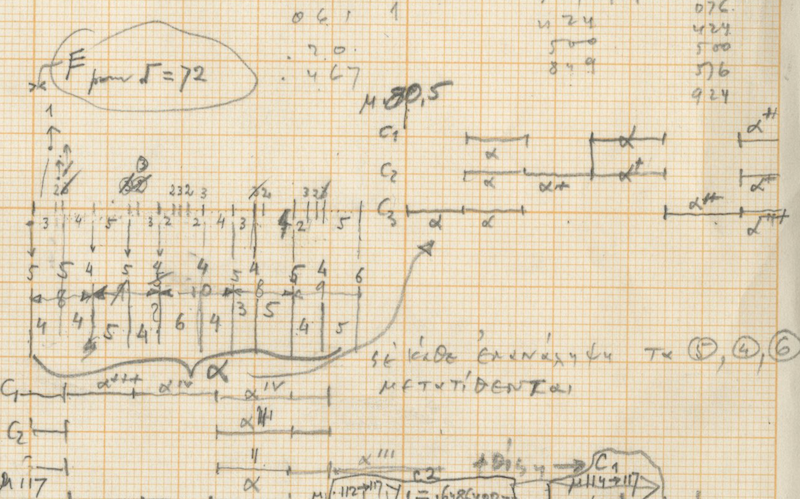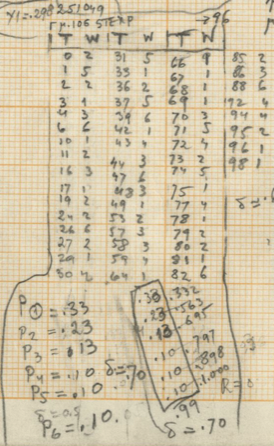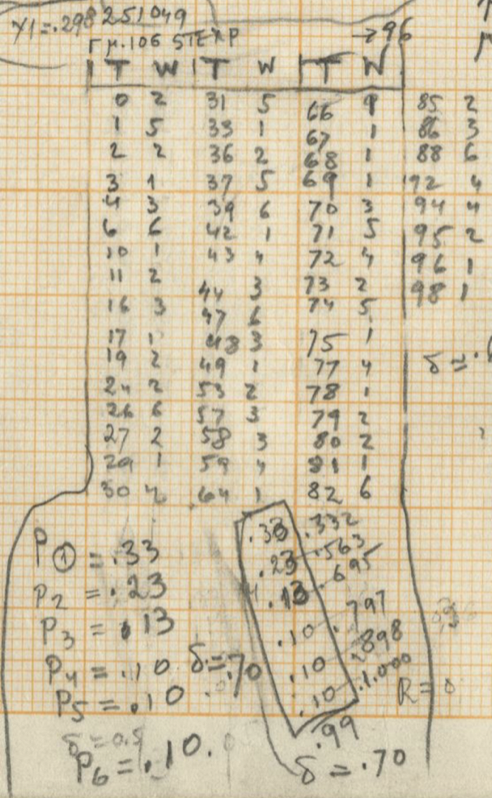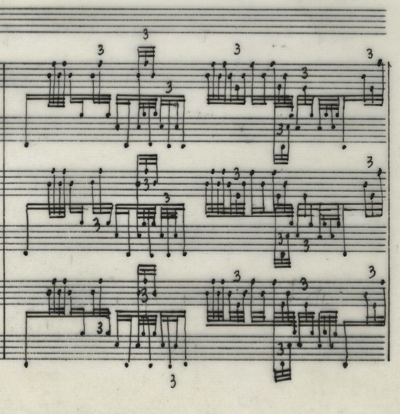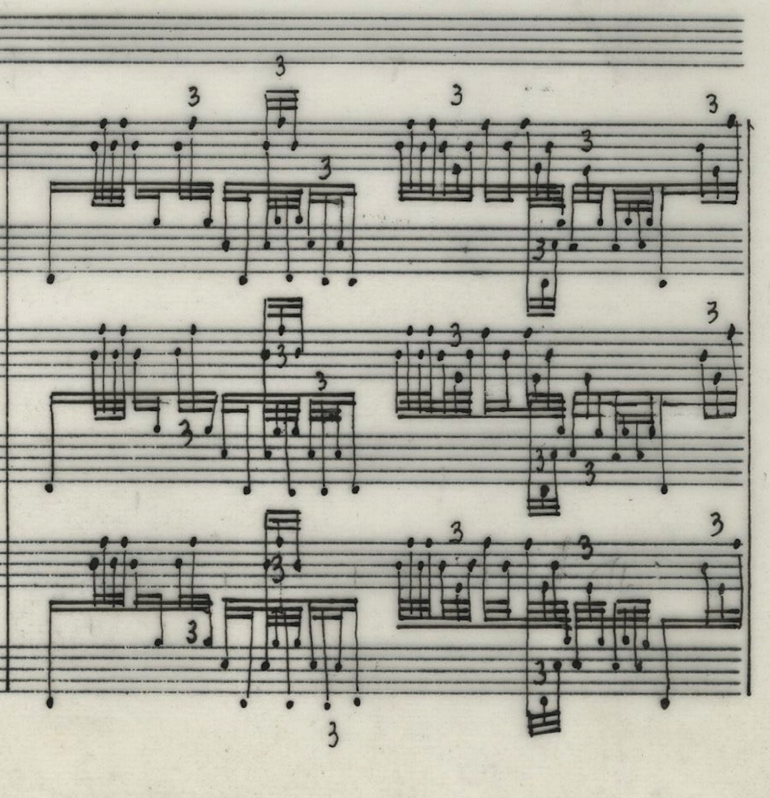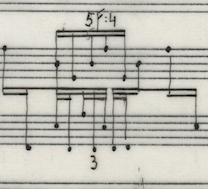Improving the practice and performance of contemporary music
Meso structure
all examples on this page are published with permission of collection Famille Xenakis. DR. and may not be copied unauthorized without permission.
Tempo 120 and 56
The initial rhythm of this section is constructed out of two elementary sieves (1, 2)
- one for the sounds at the rim of the instrument: sieve 50;
- one for the bass sounds: sieve 53 (3)
He enhances these elementary sieves in the sketches with the statement that “the following sieves can interrupt the initial pattern: 60 and 70”
Further in the sketches, he proposes that player two comes in following sieve 53 and player 3 comes in following sieve 52.This is unclear in the score and could be –according to us - altered later on in the compositional process. From our point of view Player 2 starts at sieve 52 and Player 3 at sieve 51. This proves again that Xenakis often leaves the path he initially had in mind to serve the direction his music needs.
Players two and three briefly follow respectively sieve 30 and sieve 31 respectively to interrupt the initial pattern in measures 1 and 3. Other elementary sieves that alter the initial sieves from the beginning follow the elementary sieves in the initial sketches.
We discovered through the further sketches that Xenakis randomized the choice of sound from measure 13 onward using automation – probably with GENDYN (4), the program Xenakis developed over the years to construct his musical language. We checked all the series he listed in the sketches and all the sounds can be found back in these lists (except for one transcription mistake). The lists of numbers prepare the score for constant trio playing, but the final result of the score shows some passages where the players play solo. We assume that these alterations in the orchestration of the piece were done at the final stage of the composition to add to the structure and clarity of the piece. Sometimes measures do not occur in the lists, for example measures 22-24, and are probably added later on in the composition process.
The quasi unison writing of passages like measure 13-16 implies a sort of “meta-djembe” sound. Through the permutations of the chances of occurrence of the different sounds, all sounds actually occur with more or less the same frequency. This implies that when the three players are playing together the frequencies of the different instruments cancel each other and the perceived sound changes drastically. This is also the reason why a trio passage sounds so different from a solo passage in this piece.
In the sketches Xenakis also interjects the series of sieves with moments of “chaos”. Xenakis also writes the sentence “Chaos with variable weights.” We assume that these chaos moments are the periods with tempo 56. He also states in the sketches that he wants to use elements like five over three. This illustrates, for example, measure 30. In tempo 56, again the ”display modus” is used as in Rebonds: he seems to simply display the different possibilities of the different timbres.
Tempo 80
In this section Xenakis uses quasi-palindromes (5) constructed on the Fibonacci series. These quasi-palindromes are called “quasi” because of the fact that they do not always imply perfect symmetry between the two halves and that often parts of the series are omitted during the actual composition process (for example the 8 is missing in the series in measure 67 player 1).
He first starts with a distance of 21 32nd notes distance between the first open slaps, and builds down to the roll (“ondulation”) in the following series: 21-13-8-5-3-2-1-1. After the roll, the series is turned around: 1-2-3-5-8-13-21. The rolls could be seen as point “0” in the series of Fibonacci. Also in Persephassa the middle point of the series of the quasi-palindrome is a roll.
As in the beginning of the piece, the entrance of player 1 is followed by canonical entrances of players 2 and 3. A kind of “stretto” is applied towards the end of this section, first the 21 is omitted out of the series, then 13 and even 8 at the end. Additionally, the rolls become shorter and of course more frequent towards the end. The end of this section uses again a kind of displaying modus section with rolls on the consecutive bass sounds. A large African skin is added to this spectrum here. This African drum only appears here and again as a final beat of the entire composition.
Tempo 66
This section is based on the “melodic-percussive rhythm” coming from Idmen B as Xenakis states in his sketches. (See above in the “general” chapter). He also states that the upper 3 sounds are dominant and the lower sounds are inferior. In the sketches we see a clear division between the two: the bass sounds represents only 20% of the text. If we count the bass notes of the first C3 line in this section, we can see there are 10 bass notes until the first bass slap. This equals approximately 20% of the 44 32nds of this line. If we count the 64th notes, there are 54 notes in this line.
The three bass sounds and three high sounds are then distributed into proportions such as: 0,33 for each of the high sounds; 0,05-0,05-0,23 for the low sounds. It is difficult, however, to reconstruct the exact process of this particular section, due partly to the fact that it is a copy of a former composition. We found the scheme of this section in his sketches.
In this scheme it seems that the distribution of the bass and the rim sounds was done in a similar way as the distribution of the instruments in Rebonds B. We see the written out frequency of bass and rim sounds and the addition of numbers as 2 and 3 to show when the sound is altered. Next to this worked-out example we find a scheme that shows the initial “theme” with the Greek letter Alpha and the “variations on that theme with their respective orchestration.”
Tempo 92
The material in this section was conceived in the exact same way as the material from measure 13 onward. In this section, and especially in measure 106—108 and measures 110-116, Xenakis adds the time parameter to his automation of the material, which results in the particular rhythm of these passages.
Tempo 70
Xenakis states in his sketches that the material used here is an exact copy of the musical text in Rebonds A. In this section we can find a lot of examples of the “fat” writing to enhance the rhythm as described above.
Very clear examples of this copying are:
- Measure 119: Second beat 3rd 16th: quintuplet over distinct rhythm
- Measure 133-134
This section also has two insertions of polyrhythmic lines at tempo 60 for an eighth note (measure 124-126 and measure 130-132). These are a clear example of what Anne-Sylvie Barthel-Calvet calls “Polymétries déphasées” in chapter 3.2.2.3 “Autres exemples de polymétrie déphasée” of her thesis (6). It is the same kind that Xenakis uses in Pleïades. We believe that he uses a combination of stable and evolutionary structures. For example, in measure 124-127 player 2 speeds up at the end of the phrase but the other two remain stable.
Notes
Text written by Tom De Cock © Living Scores 2015
- XENAKIS, Iannis and RAHN, John , “Sieves”, Perspectives of New Music, Vol. 28, No. 1 (Winter, 1990), pp. 58-78
- BARTHEL-CALVET, Anne-Sylvie, Le rythme dans l'oeuvre et la pensée de Iannis Xenakis, thèse de doctorat. Paris, Ecole des Hautes Etudes en Sciences Sociales, 2000, 2 vol., 700 + 482 p.: pp. 125-135
- The first number of the sieve indicates the frequency of the actual impacts, the second number indicates the departure point of the impacts. 50 means: there is an impact every five sixteenths (sixteenths for this case; the units can also be 32nds or eight notes for example), and this cycle starts on point “zero” of the piece, i.e. the first note.
- HOFFMANN, Peter, “Music out of Nothing? A rigorous Approach to Algorithmic Composition by Iannis Xenakis”, Berlin 2009, Doctoral Thesis, Fakultät I - Geisteswissenschaften der Technischen Universität Berlin, pp. 7-16
- BARTHEL-CALVET, Anne-Sylvie, Le rythme dans l'oeuvre et la pensée de Iannis Xenakis, thèse de doctorat. Paris, Ecole des Hautes Etudes en Sciences Sociales, 2000, 2 vol., 700 + 482 p.: pp. 172 and 242. These palindromes were already used in Synaphaï (Ibidem p. 172) and Persephassa (measure 150 and following). In Synaphai we can find some numbers in the series that come from Finonacci’s series, in Persephassa, the series are different.
- “Elles peuvent cependant être regroupées selon deux grandes catégories: les polymétries déphasées stables dans lesquelles chaque ligne conserve la même structure métrique et les polymétries déphasées évolutives dans lesquelles elle est variable.” Ibidem pp. 197-210
